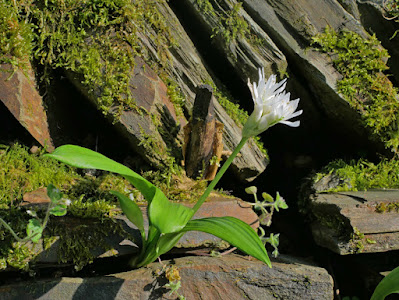Sand Crocus is a very rare native plant, only found at Dawlish Warren, Devon and on a couple of rocky outcrops near Polruan, Cornwall, on mainland UK. Online photos of some Dawlish plants now being in flower led me to plan a trip to see them. Billy, a young botanist from Bodmin joined me and we set off to see them.
One issue was that the flowers are very small and only open in bright sun. As we left it started raining and it was quite cold too, so would they be open today? I hoped the sunny spells bewteen the showers would be enough for them to be visible at least, but I wasn't very optimistic.
We had also decided to record all species we could find in the monad after being prompted by the County Recorder to do so. All recording is now worthwhile as from 2020 we are in a new 20 year date class. As such, all records after 2020 are in effect new and valuable to show continuity of species in that area.
Having decided to record everything we could, it became apparent that, like most botanists, it would take some time to get out of the car park as it was full of species. This one really caught our eye.
It's White Ramping Fumitory, but a rare form that turns white to almost crimson as the flowers age and are pollinated.
Fumaria capreolata subspecies capreolata forma speciosa
Below: look at how crimson the flowers have turned on this one, beautiful!
After recording lots of species, we arrived at the first Sand Crocus site. What a view!
The Sand Crocuses grow on the very thin soils over these granite outcrops to avoid competition from more robust species. It was a pretty cold Easterly breeze and the sun was more in than out. Where were they?
It was Billy who raised a yell as he found the first one.
He'd found one! Barely open in the poor conditions.
We then scanned the area and found lots more, over 40 in fact!
There was enough sun out after all.
Taraxacum lacistophyllum
The final plant of note from here was a plant I usually find (though rarely) in arable fields. There was a stand of Field Woundwort growing well in a rabbit scrape. It needs disturbance to germinate and here, rabbits provided it.
Stachys arvensis
As there was plenty of time left in the day, we decided to pay a visit to Lantic Bay nearby. This is a shellgrit and shingle beach surrounded by high cliffs with a long walk down (and back up 120m in fact). The flora is somewhat different to usual as the shellgrit allowed for more calcareous plants to grow here.
On
the way down the cliff, we came across a lot of rosettes of Early
Purple Orchids, but sadly, if any were to flower, it was too early for
them yet. Look at the markings on this one!
Orchis mascula
Here'a a view from halfway down the cliff to the beach
However, the top of the beach was sparsely vegetated and contained some nice plants such as Sea Spurge and Sea Radish as shown below.
Raphanus raphanistrum subspecies maritimum
I found this bug on vegetation on the beach.
https://www.britishbugs.org.uk/heteroptera/Coreidae/enoplops_scapha.html says about this bug -
"A
large and distinctive dark grey squashbug with cream markings on the
connexivum. Early instar larvae have very
spiny antennae and a green abdomen. Later instars are superficially
similar to the much commoner Coreus marginatus (Dock Bug) but the abdominal tergites
are more pointed.
A local species which
is confined to coastal cliffs and sand dunes between Kent and north Wales,
with outlying populations on the north Yorkshire coast. The foodplants are various
Asteraceae".
Enoplops scapha - Boat Bug
At the top of the beach was a small cave with fresh water dripping down from the roof. Growing about this was the largest and most impressive Maidenhair Fern I had yet seen. It must have been 3 feet long hanging down from the roof.
Adiantum capillus-veneris
Before
the long climb back up the cliff, we had a sit down on a log. Whilst
there I spotted another delicate Dandelion. This one turned out to be Taraxacum oxonianum
The last flower I photographed here was a stand of Sea Rocket. Its seeds wash up on the highest of tides and start off the next generation of plants. They are quite common around the coasts.
Cakile maritima
The vegetated beach at Lantic Bay. It was a long way back up again!
So ended a great day out. Billy was great to be around and it was good to talk botany with another person interested in the subject. We found the Sand Crocus and overall, the sites were in good condition so they should be around in the future too.
I hope you liked this blog, take care.
Dave
Follow me on Twitter - @botany2021






















































